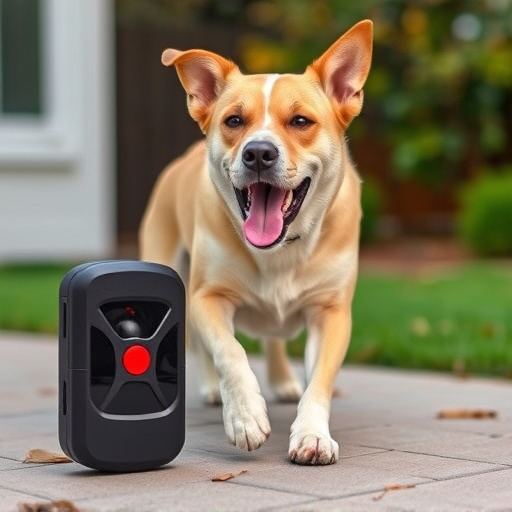This text compares stationary and mobile ultrasonic dog repellents. Stationary devices emit continuous sound waves, effective but prone to dog adaptation, while mobile units offer portability, versatility, and unpredictable sound patterns, maintaining effectiveness over time despite requiring more active management. Mobile repellents prove superior in a Stationary Vs Mobile Dog Repellent Comparison, ideal for dynamic environments, outdoor use, and travel, albeit at a higher cost; the best choice depends on space, dog intrusion frequency, and personal preference.
“Exploring Ultrasonic Dog Repellents: A Comprehensive Guide for Pet Owners. With the ever-growing range of pet care solutions, ultrasonic technology has emerged as a safe and effective method to keep dogs at bay from unwanted areas. This article delves into the workings of this innovative technology, offering a detailed comparison between stationary and mobile dog repellents. Whether you’re facing persistent dog intrusions or seeking a convenient solution, we break down the pros, cons, features, and benefits to help you choose the ideal ultrasonic repellent for your needs, highlighting the key differences in our Stationary Vs Mobile Dog Repellent Comparison.”
- Understanding Ultrasonic Technology for Dog Repellents
- Stationary Dog Repellents: Pros and Cons
- Mobile Dog Repellents: Features and Benefits
- Choosing the Right Dog Repellent: A Comparative Analysis
Understanding Ultrasonic Technology for Dog Repellents
Ultrasonic technology has emerged as a popular and seemingly effective solution for dog repellents, offering a non-toxic and humane approach to keeping canines at bay. This technology works by emitting high-frequency sound waves that are inaudible to humans but can provoke an aversion response in dogs. The key to its success lies in the difference between how dogs and humans perceive sound.
When comparing stationary and mobile dog repellents, ultrasonic devices stand out. Stationary repellents, often installed in specific areas, emit continuous sounds, which may eventually lead to habituation as dogs learn to ignore them. In contrast, mobile ultrasonic repellents are portable and can be carried or moved around, offering a more dynamic approach. This movement keeps the sound waves unpredictable, making it harder for dogs to become accustomed to the noise, thereby maintaining its effectiveness over time.
Stationary Dog Repellents: Pros and Cons
Stationary dog repellents are designed to remain in one place, usually indoors or outdoors in specific areas where dogs are a problem. They emit high-frequency sound waves that are harmless to humans but can effectively deter dogs. Pros include their ease of use and reliability; they can be left on continuously without any intervention. This makes them ideal for consistent, long-term protection against dog intrusions. However, cons include limited flexibility; once placed, they cannot be moved or adjusted to cover different areas as needs change. They also might not be as effective in highly trafficked zones or if the dogs become accustomed to the sound over time.
In contrast, mobile dog repellents offer greater adaptability, allowing users to move them around based on changing situations and needs. These devices can be taken indoors during inclement weather or moved outdoors to different problem areas. While they may require more active management, this flexibility makes them a better fit for dynamic environments. However, their effectiveness can vary depending on battery life and the user’s consistency in moving and re-positioning them.
Mobile Dog Repellents: Features and Benefits
Mobile dog repellents offer a convenient and modern solution for keeping canines at bay, especially in scenarios where traditional stationary repellents might not be feasible or effective. Unlike fixed devices that require consistent placement and power sources, mobile options are designed to be portable and versatile. These repellents often utilize ultrasonic technology, emitting high-frequency sound waves that are unpleasant to dogs but harmless to humans and other animals.
When comparing stationary and mobile dog repellents, the latter provides several advantages. Mobile devices allow for easy movement and placement according to changing needs, making them ideal for outdoor settings like gardens, patios, or even vehicles. They offer flexibility in terms of coverage area and can be carried when traveling or visiting new places where dogs are not permitted. This portability makes mobile repellents a practical choice for those seeking a dynamic solution to dog intrusion without the constraints of fixed installations.
Choosing the Right Dog Repellent: A Comparative Analysis
When considering dog repellents, one key factor is whether to opt for a stationary or mobile device. A stationary dog repellent is ideal for establishing a protected area in a specific location, such as a patio or garden. These devices emit ultrasonic sounds that are unpleasant to dogs but generally inaudible to humans, creating a barrier that discourages them from entering the space. They are cost-effective, energy-efficient, and require minimal maintenance.
In contrast, mobile dog repellents offer versatility for those who need protection on the go or in multiple areas. These devices can be easily carried and placed where needed, making them suitable for outdoor activities, parks, or even while traveling. While they might have a higher upfront cost, their mobility allows for greater flexibility and convenience. When choosing between stationary and mobile options, consider your specific needs, available space, and the frequency of dog intrusions to determine which type best suits your situation.
In exploring safe dog repellent options, ultrasonic technology emerges as a promising solution. Our comparison of stationary and mobile devices highlights their unique advantages and drawbacks, with mobile repellents offering flexibility and portability while stationary models provide consistent coverage. When deciding between these types, consider your specific needs, outdoor conditions, and the behavior of your canine companion. Ultimately, both options can effectively manage dog presence in various settings, ensuring a peaceful and harmonious environment for all.
